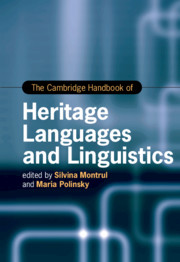Book contents
- The Cambridge Handbook of Heritage Languages and Linguistics
- Cambridge Handbooks In Language And Linguistics
- The Cambridge Handbook of Heritage Languages and Linguistics
- Copyright page
- Dedication
- Contents
- Figures and Tables
- Contributors
- Acknowledgments
- Introduction
- Part I Heritage Languages around the World
- 1 Slavic Heritage Languages around the Globe
- 2 Heritage Languages in Europe
- 3 Heritage Languages in Southeastern Europe
- 4 Heritage Languages in China
- 5 Heritage Languages in Japan and Korea
- 6 Heritage Languages in Israel
- 7 Heritage Languages in Aotearoa New Zealand and Australia
- 8 Heritage Languages in Canada
- 9 Asian Heritage Languages in the United States
- 10 The Vitality of Spanish as a Heritage Language in the United States
- 11 Germanic Heritage Varieties in the Americas
- 12 Arabic in North America
- 13 Heritage Languages in South America
- 14 Language Attrition and Heritage Language Reversal in Returnees
- Part II Research Approaches to Heritage Languages
- Part III Grammatical Aspects of Heritage Languages
- Part IV Heritage Language Education
- Index
- References
2 - Heritage Languages in Europe
from Part I - Heritage Languages around the World
Published online by Cambridge University Press: 04 November 2021
- The Cambridge Handbook of Heritage Languages and Linguistics
- Cambridge Handbooks In Language And Linguistics
- The Cambridge Handbook of Heritage Languages and Linguistics
- Copyright page
- Dedication
- Contents
- Figures and Tables
- Contributors
- Acknowledgments
- Introduction
- Part I Heritage Languages around the World
- 1 Slavic Heritage Languages around the Globe
- 2 Heritage Languages in Europe
- 3 Heritage Languages in Southeastern Europe
- 4 Heritage Languages in China
- 5 Heritage Languages in Japan and Korea
- 6 Heritage Languages in Israel
- 7 Heritage Languages in Aotearoa New Zealand and Australia
- 8 Heritage Languages in Canada
- 9 Asian Heritage Languages in the United States
- 10 The Vitality of Spanish as a Heritage Language in the United States
- 11 Germanic Heritage Varieties in the Americas
- 12 Arabic in North America
- 13 Heritage Languages in South America
- 14 Language Attrition and Heritage Language Reversal in Returnees
- Part II Research Approaches to Heritage Languages
- Part III Grammatical Aspects of Heritage Languages
- Part IV Heritage Language Education
- Index
- References
Summary
Definitions of heritage languages include the languages of migrant, indigenous, and national minorities. This chapter is concerned with migrant minorities. The EU is generally pictured as valuing multilingualism, as reflected by EU policies and citizen’s attitudes. Nevertheless, when Europeans think and speak about protecting multilingualism, they do not necessarily have migrant languages in mind, although these are more numerous than other minorities in terms of both language diversity and number of speakers. The chapter summarizes linguistic research on HSs in Europe covering early childhood, primary school/adolescence, and adulthood, making reference to (morpho-)syntax, phonology, and vocabulary. The goal is to uncover common outcomes and missing links. The focus differs across these research areas but crosslinguistic influence is a common denominator, and the examples witness that research has gone beyond highlighting differences between monolinguals and HSs. Scenarios suggest that HSs may anticipate or resist language change, and that adult HSs often stay within the limits of what is possible in the baseline or related varieties. I conclude by pointing out the lack of comparisons across generations, an overrepresentation of specific languages families, and by suggesting that research drawing analogies with other situations of language contact and change are highly desirable.
- Type
- Chapter
- Information
- Publisher: Cambridge University PressPrint publication year: 2021
References
- 1
- Cited by



